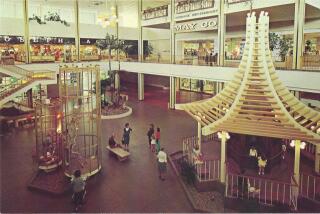Capitalism Reigns as King in Kremlin’s Shadow
- Share via
MOSCOW — In Soviet times, the sacred space just outside the Kremlin walls was reserved mostly for military parades and visitors to Lenin’s tomb.
These days, it boasts one of Russia’s glitziest shopping arcades and will soon have a second--the new one stretching three stories underground to the walls of the Kremlin itself.
Once a showcase of Communist power, Red Square and the area surrounding the Kremlin has metamorphosed into the ideological opposite: a showcase of commerce.
“In those days, this place was political. Now it’s commercial,” says Alexander Kostinin, a factory director who travels to Moscow every few weeks from the southern city of Samara to shop with his wife.
Across from Lenin’s mausoleum in Red Square sits the reborn GUM shopping center, whose bright signs for Christian Dior and Levi’s rival the red stars still atop the Kremlin towers. Instead of slogans praising Lenin’s legacy or exhorting hard work, banners advertise carpets and electronics.
Coming next is a vast, three-story underground shopping complex known as Manezh Square, which will include a food court, fountains and top-name retail stores like Donna Karan and Dolce & Gabbana.
The new mall is a showpiece of Mayor Yuri Luzhkov’s ambitious plans to de-communize and re-Russify the capital before the city’s 850th anniversary in September.
The transformation is impressive but not yet complete. Remnants of Soviet times mix oddly with the new consumer trade.
A few hundred yards from Red Square, a statue of Karl Marx still proclaims, “Proletariat of the World--Unite.” Across the street, an electronic billboard flashes ads for Swiss watches and slot machines.
A sign on the doors of the former Central Lenin Museum offers perhaps the greatest indignity to the memory of the anti-capitalist revolutionary: “Stock sold here.”
Shares in what? The underground mall.
Some worry that the Kremlin area has become retail-saturated, and cite news reports that the city is having trouble finding tenants for the new mall.
But others, such as real estate agent Mark Treves, believe the center of Moscow is becoming like the center of any European city: the locus of economic as well as political power.
“People forget that this was always a prime retail area,” says Treves, who works for the Moscow office of Jones Lang Wootton. “Red Square itself was a very big market.”
The rebirth of GUM--the once dowdy, now fancy arcade on Red Square--is a lesson in the cycles of Russian commerce.
Built on a site used for centuries by small-scale traders, the glass-ceilinged, three-tiered arcade opened in 1893 in the waning years of Russia’s czars as the Superior Trading Arcade. Its carved cornices, arching pedestrian bridges and scrolled ironwork rivaled the best in Europe.
It was shut within months of the Bolshevik Revolution and fell quickly into disrepair and ideological limbo. Although it reopened for about nine years as the State Department Store--known by its Russian acronym GUM--Soviet dictator Josef Stalin closed the store again in 1931, using its pastel-painted corridors for offices and a government printing house.
Several times, the government discussed tearing it down altogether to make more room for the phalanxes of tanks that rolled through Red Square on holidays.
In part because of the distractions of World War II, GUM survived. It reopened after Stalin’s death in 1953, and became the butt of tourist jokes.
Rows and rows of stalls displayed the best the Soviet Union could produce in the way of consumer goods: cheap china, wool stockings, unfashionable shoes. The shabbiness was highlighted by the lines that quickly formed whenever imported goods were on sale.
“This was actually an anti-Soviet place,” shopper Tatiana Shkolnikova recalls as she sips a milkshake near the gilded fountain at the center of the arcade. “Everyone would run to buy a Finnish dress, Yugoslavian slippers, a Hungarian TV.”
Now, nearly everything for sale is imported. That irks some Russian shoppers, along with the high prices--491,000 rubles (nearly $90) for a pair of Levi’s 501 jeans, 180,800 rubles ($30) for 2 ounces of Ralph Lauren after-shave.
“I buy big things elsewhere. Here, I can only afford small things, like cosmetics,” complains Nadezhda Amyelyichkina, a shopper snacking on a hot dog and coffee.
But she thinks politics and commerce can and should co-exist in the center of the capital.
“That’s the way it is all around the world--the historic center and the trade center are the same,” she says. “We’re becoming more like the rest of the world.”
More to Read
Sign up for Essential California
The most important California stories and recommendations in your inbox every morning.
You may occasionally receive promotional content from the Los Angeles Times.













